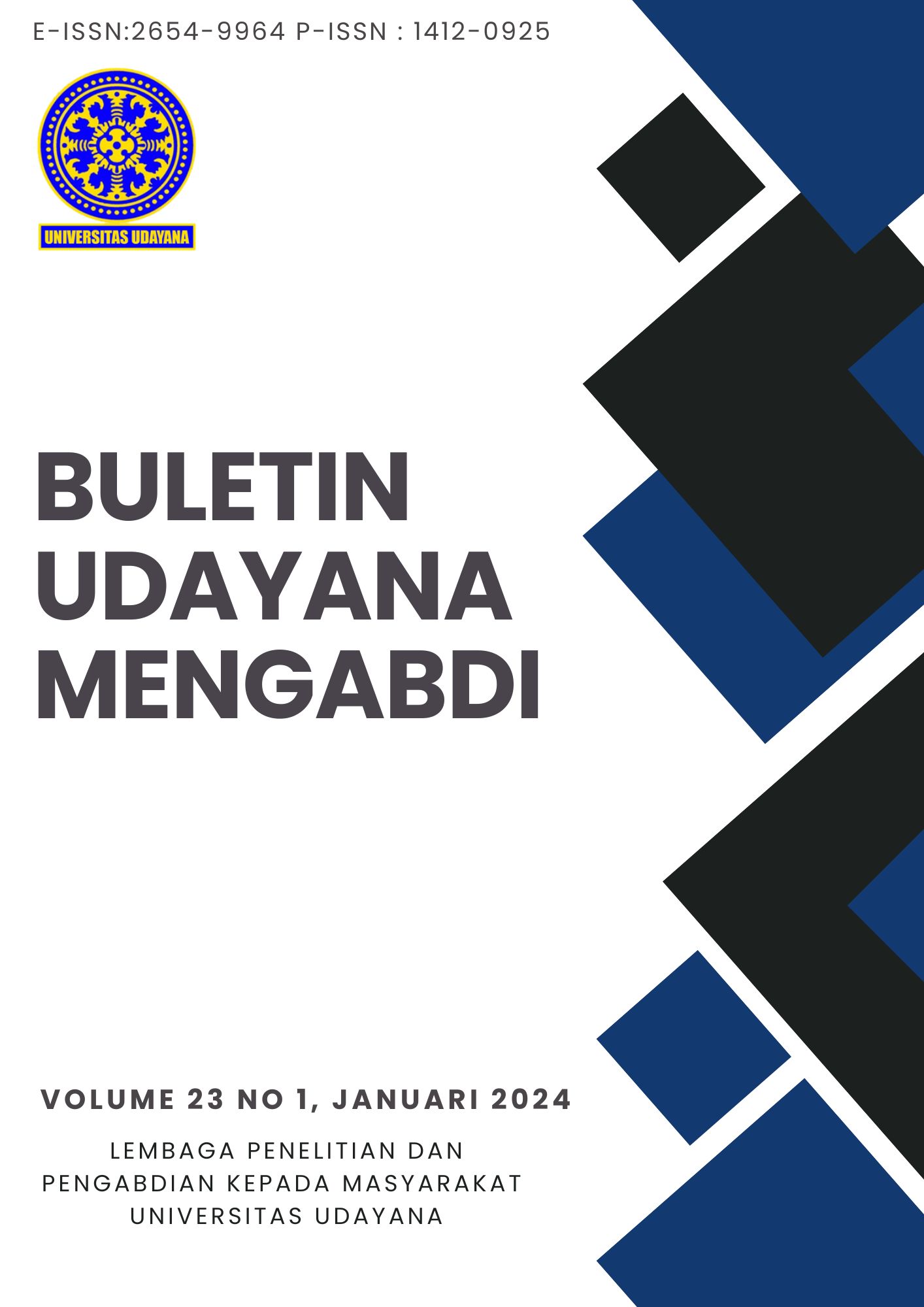PEMBUATAN PERCONTOHAN KERAMBA JARING APUNG (KJA) RAMAH LINGKUNGAN DI PERAIRAN DANAU
Abstract
Cultivating freshwater fish using floating net cages (KJA) causes an increase in the nutrient content of uneaten feed and fish feces. Making a KJA pilot using aquatic plant biofilters capable of absorbing pollutants and of economic value, such as water spinach, bok choy, and red spinach, is carried out to socialize pollution from KJA activities and water quality management. The implementation of activities applies the Participatory Learning and Action (PLA) method by involving the Fish Farmers Group in Lake Batur in designing and installing environmentally friendly KJA. The KJA system consists of 3 (three) principal components, i.e., a watertight pond, a reservoir for leftover feed waste, and aquaponic plants. The community can understand the pollution and the importance of managing water quality based on the evaluation results. Besides that, through the direct involvement of the community, the design and application of KJA were produced following the conditions of the waters in Lake Batur. This relates to the layout of the components, namely the placement of a window for water circulation between the KJA pond and lake waters in a watertight pond, the order of a tank to hold leftover feed and fish feces as a result of suction from the bottom of the pond in the middle of the KJA, and the planting of plants in the planting medium pipe on the side of the KJA pond. Besides being helpful in environmental management, this KJA installation can be useful for increasing the economy through plant cultivation.
Keywords: Aquaculture, Participatory Learning and Action (PLA), Lake Batur Waters, Environmentally Friendly Floating Net Cages (KJA), Water Quality Management.
Downloads
References
10: No. 2, pp. 87–97.
Astuti, L. P., & Indriatmoko. (2018). Kemampuan Beberapa Tumbuhan Air dalam Menurunkan Pencemaran Bahan Organik dan Fosfat untuk Memperbaiki Kualitas Air. Jurnal Teknologi Lingkungan, Vol. 19: No. 2, pp. 183–190.
Dauhan, R. E. S., Efendi, E., & Suparmono. (2014). Efektifitas Sistem Akuaponik Dalam Mereduksi Konsentrasi Amonia Pada Sistem Budidaya Ikan. E-Jurnal Rekayasa Dan Teknologi Budidaya Perairan, Vol. 3: No. 1, pp. 297–302.
Dinas Perikanan Kabupaten Bangli. (2020). Perikanan Budidaya di Kintamani Tahun 2020.
Gorlach-Lira, K., Pacheco, C., Carvalho, L. C. T., Melo Júnior, H. N., & Crispim, M. C. (2013). The Influence of Fish Culture in Floating Net Cages on Microbial Indicators of Water Quality. Brazilian Journal of Biology, Vol. 73: No. 3, pp. 457–463.
Kementerian Lingkungan Hidup Republik Indonesia. (2014). Gerakan Penyelamatan Danau (GERMADAN) Batur.
Komariah, S., Waspodo, R. S. B., & Chadirin, Y. (2016). Keefektifan Zeolit dan Arang Sebagai Bahan Penyusun Akuifer Buatan (Artificial Aquifer) Untuk Menurunkan BOD dan COD Air Sungai. JTEP Jurnal Keteknikan Pertanian, Vol. 4: No. 2, pp. 9–14.
Nurwati. (2014). Evaluasi PLA (Participatory Learning and Action) Malaria. Media Kesehatan Masyarakat Indonesia, Vol. 10: No. 4, pp. 193–199.
Putri, N. N. S., Putra, I. D. G. A. D., & Rajendra, I. G. N. A. (2021). Analisis Kesesuaian Penggunaan Lahan pada Sempadan Danau Batur, Provinsi Bali. Journal of Regional and Rural Development Planning, Vol. 7: No. 1, pp. 29–41.
Radiarta, I. N., & Sagala, S. L. (2012). Model Spasial Tingkat Kesuburan Perairan di Danau Batur Kabupaten Bangli Provinsi Bali Dengan Aplikasi Sistem Informasi Geografis. Jurnal Riset Akuakultur, Vol. 7: No. 3, pp. 499–508.
Septiani, N. K. A., Suyasa, I. W. B., & Rai, I. N. (2022). Analisis Kualitas Air dan Strategi Pengendalian Pencemaran di Danau Batur Mengunakan Analisis Force Field. Ecothropic, Vol. 16: No. 1, pp. 10–19.
Setijaningsih, L., & Umar, C. (2015). Pengaruh Lama Retensi Air Terhadap Pertumbuhan Ikan Nila (Oreochromis Niloticus) Pada Budidaya Sistem Akuaponik Dengan Tanaman Kangkung. Berita Biologi, Vol. 14: No. 3, pp. 267–275.
Wang, X., Olsen, L. M., Reitan, K. I., & Yngvar, O. (2012). Discharge of Nutrient Wastes from Salmon Farms: Environmental Effects, and Potential for Integrated Multi-Trophic Aquaculture. Aquaculture Environment Interactions, Vol. 2, pp. 267–283.
Zidni, I., Iskandar, Rizal, A., Andriani, Y., & Ramadan, R. (2019). Efektivitas Sistem Akuaponik Dengan Jenis Tanaman yang Berbeda Terhadap Kualitas Air Media Budidaya Ikan. Jurnal Perikanan Dan Kelautan, Vol. 9: No. 1, pp. 81–94.

This work is licensed under a Creative Commons Attribution-ShareAlike 4.0 International License.

This work is licensed under a Creative Commons Attribution-ShareAlike 4.0 International License.




.png)


1.png) GARUDA - GARBA RUJUKAN DIGITAL
GARUDA - GARBA RUJUKAN DIGITAL



